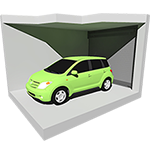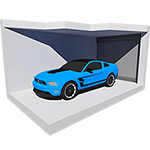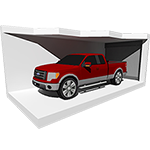If you're considering long-term car storage, there are a few steps you must take to protect your car from damage.
Changing the oil and filter in your car at regular intervals is very important. It can keep the engine cleaner, and help your car run longer. It's also vital if you're putting your car into a storage unit. It may be required if your car is under warranty. If you don't do regular maintenance on your car, you may not be able to have warranty work done on it, because the lack of maintenance could have caused a problem or made it worse. Even if your car isn't under warranty any longer, you still want to take good care of it, and a lot of that care comes from simple things like making sure the oil has been changed on a proper schedule.
While many people take their car to a dealership or a mechanic to have the oil and filter changed, you don't have to do that. You can change the oil in your vehicle yourself if you follow a few simple steps. While not every vehicle is the same, it's usually not too hard to locate the dipstick to check the oil, and to find the drain plug and the cap where the new oil goes in. Doing it yourself is also often cheaper, and you can change the oil and filter at your convenience, instead of working around a mechanic's schedule. That's a great way to get more accomplished in a short period of time, so you can get your car stored properly.

Drain your cooling system and refill it with a new 50/50 mixture
The cooling system is among the most important parts of your car. You don't want to neglect it, or your car could overheat and stop working, causing you to be stranded somewhere. When your car is in a self storage unit, you also don't want to take the chance of having anything freeze. If you just have water in your vehicle's radiator, it can freeze in the winter and lead to cracks and other damage. Repairing that kind of a problem can be very expensive, and the car would likely have to be towed to a mechanic, costing you even more. Rather than take that chance, it's better to drain the cooling system and refill it with a 50/50 mix of antifreeze and water before you put the car into storage.
You could take the car to a mechanic to have that done, but it's also something you can do yourself, to save time and money. Since some makes and models of cars have to be handled differently, it's important to consult your owner's manual for the proper way to drain and refill your cooling system. That way, you'll be sure to do it right and you won't be putting your car at risk. Be sure to use good antifreeze, too, especially if you live in a climate where winters are harsh. You don't want to take a chance on your vehicle's radiator and cooling system freezing and becoming damaged while it's stored away.

Top off the transmission/differential/steering box
Your transmission, differential, and steering box are essential components of your car, even if you're putting that car into a storage unit for a while. Depending on whether you have an automatic or manual transmission, there will be different ways to top off the fluid or grease that it requires. The differential and steering box also have to be addressed, because leaving any of those systems low can mean damage will occur while your car is sitting idle. Whether you're storing your car for just a couple of months, or you have to store it for a lot longer than that, it's always best to make sure every system is primed and ready to go when you retrieve your car. Ensuring the car will work right when you get it back is a big part of storing it.
When you put a car into storage, letting it sit for a long time can really take a serious toll on the engine, transmission, and other systems. However, you may not want to pay a mechanic to do some of the simpler things that can be done easily at home. Rather than spend a lot of money to have your vehicle's fluids checked and topped off, locate the reservoirs yourself and add fluid if needed. Your owner's manual can show you where the reservoirs are located, so you can be sure you're checking the right things. If any are low, be sure to get the right type of fluid for your vehicle, and fill it up with the proper amount.

Top off the brake fluid
Brake fluid matters. If you don't have enough fluid in your brake system, you could end up with brakes that feel "spongy" and that don't adequately stop the car properly. Naturally, that's something you want to avoid. It can be a serious hazard, and can put your life and the lives of others at risk. Even if you're putting your car in a self storage unit for a while, you still want to make sure the brake system is topped up and ready to go. It's one less thing you have to worry about when you pick your car up from storage and start driving it again. Having a full brake system can also be easier on the car, since it's designed to have a certain level of fluid in it.
You don't want to risk problems such as parts drying out because they don't have fluid on them like they're supposed to. When brake fluid is low while the car is in storage, that lack of fluid could mean serious problems. Fortunately, topping off brake fluid is very easy. You just need to locate the reservoir on your car, and make sure it's filled to the proper line. If you do that you'll have adequate brake fluid, along with less to worry about. Then you can focus on any other issues your car might have, or on other things you need to take care of, so you can get your car back out of storage faster and in good condition.

Wash and wax the exterior
Protecting a car's finish while it's in a self-storage unit is very important. Even if you feel like your car is protected from normal wear and tear because it's out of the elements, it can still become damaged. It's going to be exposed to heat and cold, and it's also going to collect dust. Over time, those kinds of things can damage the paint, and you don't want that to happen. Whether it's nearly new, or it's an older car that's still in great shape, you should wash and wax the exterior before putting it into storage. That's especially important if you're going to store your car for a long period of time, but should be done even for short-term storage.
Just about anyone can wash and wax a car, but you want to make sure you do it the right way. Improper washing and waxing can actually be hard on your vehicle's finish, so take your time and do things the right way. By using the proper type of detergent and focusing your efforts on correct waxing technique, you'll be able to ensure that your car's finish is as protected as possible. Any dust that accumulates on your car will be easy to remove if the car is properly waxed, and the heat and cold won't affect the paint as much, as it's well worth taking the time to do.

Vacuum the interior
It's not just the outside of your car that should be clean when you put it into a self-storage unit. You also want to make sure the interior is vacuumed and cleaned out very well. Many cars have dust, dirt, plant matter, sand, mold spores, and other things in them, just from someone getting into and out of them frequently. Your car is likely no exception, but you can reduce the risk of having any of that cause you a problem if you vacuum your car thoroughly before you put it into storage. That can also help get rid of odd smells that you might otherwise encounter from things left in your car.
There are two ways to vacuum out your car. You can use your home's vacuum cleaner, or you can go to a car wash where they have the large, coin operated vacuum machines. Both are good options, depending on how much you need to get out of your car and whether your home's vacuum cleaner is a good one. You definitely don't need to pay someone else to clean the interior of your car for you, though. You can do it yourself, which will save you time and money. Thoroughly vacuum the entire car, and also make sure you vacuum the seats and door pockets. It's easy to miss something if you don't get all the cracks and crevices, so get the car as clean as possible.

Disconnect the battery
Cars that are placed into a self-storage unit situation need to have their battery disconnected. If you don't do that, your car's battery will be dead when you come back to get your car, especially if you leave it in the storage facility for months. That happens because there are small systems in any vehicle that pull a little bit of power. Things like your clock running, or your radio holding preset stations all take a tiny bit of battery power. To avoid your battery going dead, you can disconnect it. Sure, you'll have to reset the clock and the radio, but it's well worth it when you're not stuck with a dead battery when you try to get your car out of storage later.
Disconnecting the battery isn't hard to do, but you do want to be careful with it. Batteries carry a charge, and you could be injured if you don't take it loose the proper way. Take your time and make sure you understand how to take a battery loose safely. You could have someone do it for you, but you can certainly do it yourself and not risk any harm as long as you understand what you're doing. Reading up on batteries and having the right tools are both important, so you can get your car into the storage facility and disconnect the battery, so your car has the best chance of starting when you come back to get it at a later date.

Clean the battery connector with a solution of baking soda and water
It's very important to make sure that the battery connectors are clean. They can corrode, even if you live in a dry climate. If you're in a more humid or damp climate, though, they're more likely to suffer from corrosion. That corrosion can mean the battery won't provide adequate power, or that power will have trouble making it through to the systems that need it. With that in mind, you can keep your battery connectors clean while your car is in a storage unit. Baking soda and water is the best way to clean battery connectors. It's gentle, but yet it's also very effective, so you can get what you need from it and not worry about harm to your car's electrical system.
Just make sure you understand how to safely and properly clean your battery connectors, so you don't end up damaging anything in the process. If you understand how to do it the right way, you can end up with very clean battery connectors that you can easily put back onto the battery when you get ready to get your car out of storage. That's a good feeling, especially when you've done something like that yourself and have accomplished what you want to do. It's also one less worry when your car is being stored, because you'll be able to reconnect the battery and start your car right up when you're ready to take it out of storage and to your new home.

Slip a plastic baggie over the exhaust tip and secure it with a rubber band
Protecting the exhaust tip can help keep moisture out of the engine. Most people don't think about that, but it's not that hard for a car to accumulate moisture. Damp or humid climates naturally put a car in a storage unit at risk, but it's not just about the level of moisture in the air. There's more to the issue, and the risk, than that. Even cars in drier climates can end up with moisture problems in their engines if they stay in a storage facility for too long. You can avoid that, with the plastic baggie and rubber band trick, so don't forget to take those items with you when you plan to put your car in a storage facility.
As your car sits in storage, it will experience temperature changes. When it goes from very warm during the day to cool at night, condensation can occur. That's especially true on metal, which is what your car's exhaust pipe and much of your engine is made from. To avoid that condensation and the resulting potential moisture problem, the baggie and rubber band over the exhaust tip can be a very good idea. If your car is only being stored for a couple of weeks you may not need it, but if you plan to keep your car in storage a lot longer than that, it may be well worth the few seconds it takes to place the baggie and slip on the rubber band.


















